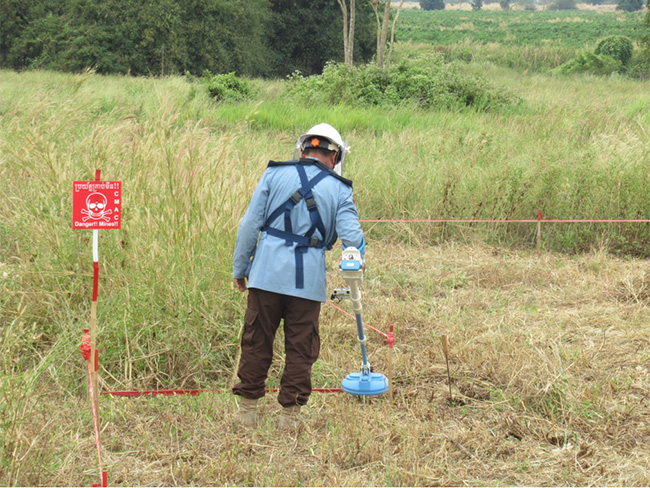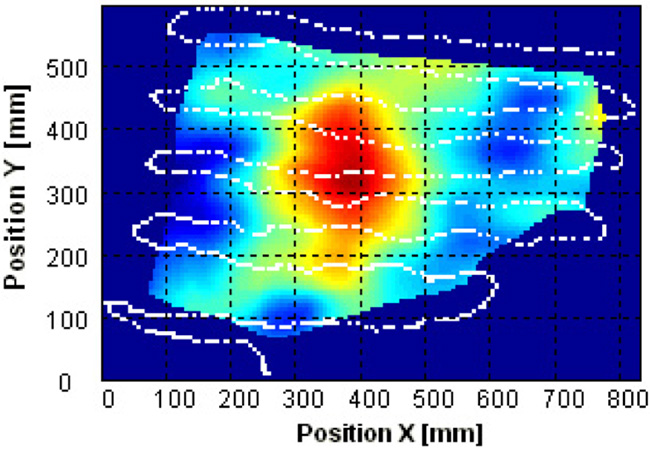Humanitarian demining is still quite an important activity in many mine affected countries. Since the Ottawa treaty established in 1997, land mine problems have been widely known, and we have continued efforts to demolish all landmines including buried mines in mine affected countries. However, we have noticed that in many mine affected countries, mine clearance is not an easy task and we are continuing this effort. It is reported that accidents caused by landmines occurred in 56 countries in 2016, and more than 9,000 people were killed or injured. As of November 2017, landmines remain in 61 countries, and we expect demining operations will need to continue for more than 20 years from now.
The Japan Science Council started a discussion on the possibility of the scientific contribution to humanitarian demining in 1999, and based on this discussion the JST (Japan Science and Technology Agency) launched the project of gPromoting Research and Development for Humanitarian Demining"(1)DThe research group of the award winners started the development of ALIS (Advanced Land Mine Imaging System) under the support of this project.
ALIS is a hand-held sensor combining EMI sensors, which is also called a gmetal detectorh, and Ground Penetrating Radar (GPR), and it can be operated by an operator by hand. The sensor is equipped with an accelerometer to estimate the sensor position. One of the unique technical points of ALIS is that it can use Synthetic Aperture Radar (SAR) processing for GPR image reconstruction [3]. As far as we were concerned, there are no other dual sensors which can use SAR processing for obtaining GPR images for hand-held GPR sensors, which can be used for landmine detection.
After they competed the development of a prototype of the ALIS, they tested the ALIS in Cambodia under the support of JSPS Grants-in-Aid for Scientific Research. They published many academic papers on ALIS development, and ALIS is widely recognized, and some of them were awarded, which include the SAGEEP Best paper (2), and IEICE Kiyasu award(3).
They conducted an evaluation test of the prototype ALIS in Cambodia in 2009 together with the CMAC (Cambodian Mine Action Centre). Then, the CMAC gave certification to ALIS for operation for humanitarian demining and decided to use ALIS in mine clearance operations in mine fields. Tohoku University and the CMAC agreed to organize a team for ALIS and 2 sets of ALIS systems have been used in mine fields since 2009. Figure 2 shows an example of images obtained by ALIS in a mine field in Cambodia. A PMN-2 anti-personnel mine, which is a plastic mine having a diameter of 8cm buried in soil is clearly imaged.
Since 2009, a mine area of more than 254,867m2 has been cleared, and more than 82 mines have been detected by ALIS. In total, 15,621 metal fragments were detected, and demines have judged that 12,081 (77%) detected objects out of them were not mines. There was not the case that a mine was judged as a fragment. This means, if ALIS is used for mine clearance operations, more than 70 % of detected objects by metal detectors do not have to be excavated as possible mines. We believe this will drastically shorten the time for excavation.
Machine demining, where a large machine crashes buried mines cannot be used inside local villages. It should be noted that hand-held sensors are used for confirmation, after machine demining operations have been carried out.
They have continued the hardware development of ALIS and it was completed in 2017. ALIS is now composed from one unit, which includes the EMI and GPR sensor head and its electronics and batteries, and an Android tablet which is used for SAR processing and data display. ALIS started operating in real mine fields in Cambodia in January 2019. This research is unique because radio science is used for the establishment of peace and it is quite important. Prof. Sato and Dr. Takahashi richly deserve the IEICE Achievement Award from these outstanding achievements.
Fig.1 ALIS working at a mine field in Cambodia
Fig. 2 ALIS GPR image of buried mine acquired in Cambodia
References
- JST, "Promoting Research and Development for Humanitarian Demining" http://www.jst.go.jp/kisoken/jirai/index.html
- Motoyuki SATO, Kazunori TAKAHASHI and Yuya Yokota, "ALIS- GPR 3-D Imaging for Humanitarian Demining", pp627, SAGEEP Meeting in Tucson, Arizona, March 2012 https://doi.org/10.4133/1.4721812 (Best Paper Award)
- Riafeni Karlina and Motoyuki SATO, "Model-Based Compressive Sensing Applied to Landmine Detection by GPRC" IEICE Transactions on Electronics, E99-C(1), pp44-51, 2016. (2017IEICE Kiyasu Award)





